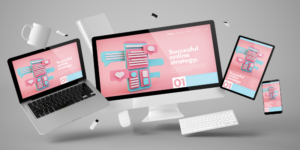The world of design is constantly evolving, driven by the intersection of creativity, technology, and social changes. As we move towards the future, new trends are emerging and shaping how we design and interact with the world around us. In this article, we will explore some of the emerging trends that are defining the future of design and how they are impacting the industry.
Sustainable and Eco-friendly Design: The concern for sustainability and environmental preservation is driving a significant shift in design. Sustainability is now a priority, and designers are incorporating eco-friendly practices and materials into their projects. From using recyclable materials to implementing energy-saving strategies, sustainable design is becoming an essential approach to create responsible and conscious solutions.
Immersive User Experience: The growing influence of virtual reality (VR) and augmented reality (AR) is transforming how we design experiences for users. With immersive technology, designers can create interactive virtual environments that allow users to explore and interact with products, services, and information in engaging and impactful ways. Immersive user experience is revolutionizing sectors such as gaming, tourism, education, and more.
Adaptive Design: With the rapid advancement of technology and the proliferation of devices and platforms, adaptive design is becoming crucial. Designers are developing flexible and responsive solutions that automatically adapt to different devices, screen sizes, and usage contexts. Adaptive design ensures that the user experience is consistent and optimized, regardless of the device or platform the user is interacting with.
Artificial Intelligence in Design: Artificial intelligence (AI) is playing an increasingly important role in the design process. AI can analyze large amounts of data, identify patterns, and provide valuable insights for designers. Additionally, AI is being used for automating repetitive tasks such as layout creation, color palette generation, and even creating custom designs based on user preferences. The integration of AI in design is accelerating the creative process and expanding the possibilities for innovation.
Inclusive and Accessible Design: Inclusion and accessibility are becoming essential considerations in design. Designers are working to create solutions that meet the needs of a diverse audience, including people with physical, visual, auditory, and cognitive disabilities. This involves creating intuitive interfaces, using captions and audio descriptions in audiovisual content, developing ergonomic products, and more. Inclusive and accessible design allows all users to have an equal and meaningful experience.
Remote Collaboration: The global pandemic has accelerated the adoption of remote work and, consequently, remote collaboration among design teams. Remote collaboration tools and platforms are becoming essential in facilitating effective communication and collaboration between designers, regardless of their geographical location. Remote design enables multidisciplinary teams to collaborate efficiently, share ideas, review projects, and drive real-time innovation.
Conclusion:
As we move towards the future, design will continue to evolve and adapt to the ever-changing needs and demands. The emerging trends we have explored in this article are shaping the industry and influencing how we design and interact with the world. From the pursuit of sustainability to creating immersive experiences, design plays a crucial role in transforming our environment and enhancing human interactions.
As designers, it is essential to stay aware of these trends and embrace change. By incorporating the principles of sustainability, immersive user experience, adaptive design, artificial intelligence, inclusive design, and remote collaboration into our work, we can drive innovation and create meaningful solutions that cater to the needs of our audience.
The future of design holds exciting possibilities. As we venture into this new territory, we must remain curious, open to new ideas, and willing to challenge the status quo. With passion, creativity, and commitment, we can harness the power of design to shape a better and more inspiring future for all.
The future of design is a realm of endless possibilities and opportunities. The emerging trends discussed in this article are just a glimpse of the transformative changes happening in the industry. As we navigate this dynamic landscape, it is crucial for designers to embrace these trends and adapt their approach to stay relevant and innovative.
Designers must recognize the importance of sustainability and eco-friendly practices in their work. By incorporating sustainable materials, energy-efficient strategies, and responsible design principles, we can contribute to a more environmentally conscious and ethically driven industry.
The rise of immersive user experiences opens up new avenues for creativity and engagement. Designers have the power to transport users into virtual realms, enhance real-world experiences, and create memorable interactions. By leveraging technologies like virtual reality and augmented reality, we can blur the boundaries between physical and digital spaces, making design an immersive and captivating journey.
Adaptive design is crucial in an increasingly connected world where users interact with various devices and platforms. Designers need to ensure seamless experiences across different screen sizes, resolutions, and contexts. By embracing adaptive design principles, we can deliver consistent and optimized experiences that adapt to the unique needs and preferences of each user.
Artificial intelligence is revolutionizing the design process, empowering designers with new tools and insights. By harnessing AI capabilities, designers can automate repetitive tasks, gain data-driven insights, and unlock new realms of creativity. Embracing AI in design opens up possibilities for efficiency, innovation, and personalization.
Inclusive and accessible design is not just a trend but a moral imperative. Designers must create solutions that cater to the diverse needs of all individuals, ensuring equal access and usability. By considering accessibility from the early stages of the design process, we can break down barriers and empower individuals with disabilities to engage fully with our creations.
Remote collaboration has become a necessity in our increasingly global and interconnected world. Design teams are now working across borders, time zones, and cultures. Embracing remote collaboration tools and fostering effective communication is key to ensuring seamless teamwork, creativity, and productivity. Remote collaboration allows diverse talents to come together, fostering a rich and global design community.
As we conclude this exploration of emerging design trends, it is clear that the future of design is both exciting and challenging. Designers must stay adaptable, curious, and open to learning. By embracing these trends and continuously evolving our skills, we can drive positive change, create meaningful experiences, and shape a future where design truly has the power to inspire, connect, and transform.
The path ahead may be uncertain, but with a deep passion for design, a commitment to innovation, and a user-centric approach, designers can lead the way in defining the future of the industry. Let us embrace these emerging trends, explore new horizons, and strive to make a lasting impact through our creative endeavors. Together, we can shape a future where design transcends boundaries, fosters connections, and enriches the lives of people around the world.



